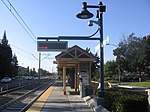Rancho Milpitas
1835 establishments in Alta California1835 in Alta CaliforniaBuildings and structures in Milpitas, CaliforniaCalifornia ranchosMilpitas, California ... and 1 more
Ranchos of Santa Clara County, California

Rancho Milpitas was a 4,458-acre (18.04 km2) Mexican land grant in Santa Clara County, California. The name comes from the Nahuatl word for maize and could be translated "little cornfields". The grant included what is now the city of Milpitas.
Excerpt from the Wikipedia article Rancho Milpitas (License: CC BY-SA 3.0, Authors, Images).Rancho Milpitas
Yosemite Drive, Milpitas
Geographical coordinates (GPS) Address Nearby Places Show on map
Geographical coordinates (GPS)
| Latitude | Longitude |
|---|---|
| N 37.43 ° | E -121.87 ° |
Address
Yosemite Drive 1926
95035 Milpitas
California, United States
Open on Google Maps








